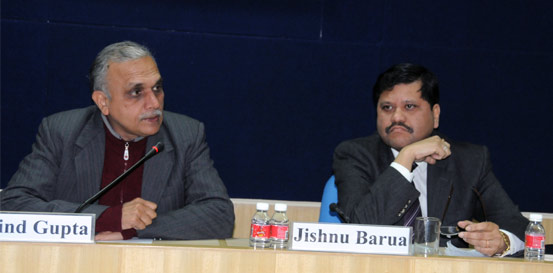
- This event has passed.
Security and Development Challenges in Assam
February 17, 2012

Mr. Jishnu Barua, Home Commissioner, Government of Assam delivered a talk on ‘Security and Development Challenges in Assam’, with a broad outline on Assam’s position in North East India, social and cultural trends, impact of colonial administration, legacy of freedom movement in Assam, 1920-1947, economic situation and some of its positive pointers, along with challenges to security and development, the State government’s response and what could be an alternative approach to durable stability in Assam.
Bringing out the geographical position of Assam, the speaker highlighted the composition of Assam of colonial times which comprised of entire North East India except for the states of Manipur and Tripura which were separate entities. He emphasised that while Assam had wholeheartedly participated in the country’s freedom struggle along with rest of India, there has always been an undercurrent of regionalism and sub-regionalism in the state. While bringing in the history of Assam to the forefront, Nehru’s visit to Assam in 1937 was described as an eventful occasion as it conveyed to him, the fears of the people of being swamped by migrants. The constant refrain of the Assamese during Nehru’s visit was that Assam was ‘invaded’ by migrants from East Bengal, which had given rise to the feeling of insecurity among the Assamese.
Mr. Barua pointed out that, in the pages of history, North East as a concept remained as an ‘artificial construct’. He also stressed on the impact of colonial administration on Assam since the British had a prolonged presence in Assam. In the development context, the socio-economic trend and indicators over the years have showed stagnation of development process in the North-East region as a whole, which is highlighted by the fact that in 1951, the state of Assam, which then included the states of Nagaland, Mizoram and Meghalaya, had per capita income which was more than the national average and ranked fifth highest in the country.
Touching upon the aspects of social and cultural trends, the Vaishnavite cult spread in Assam in an immense manner. The Assamese caste system was quite fluid before the arrival of the British when there was mobility within castes and ethnic inclusion. In comparison, the speaker notes, the current trends seem to broadcast the prevalence of ethnic assertion, ‘retribalization’ and ethnic groups taking recourse to ‘myth making’. The composite culture of Assam is narrated as showing signs of disintegration. At the same time, however, people of Assam are seen to be increasingly observing some pan-Indian social and religious practices, influenced, no doubt, by mass media, better communication and connectivity with rest of India.
Economically, Assam has shown significant trends in terms of positive economic pointers. The per capita income in terms of GDP growth rate has also increased. Both agriculture and service sector have increased to a certain extent and its economy is moving on a higher growth trajectory.
Mr. Baruah stressed on the challenges Assam faces in various areas, primarily in security and development sectors which includes the immigration and demographic transformations undergoing in the state. The speaker also pointed out the manner in which other neighbouring states, especially Arunachal Pradesh and Nagaland, are claiming parts of Assam. In this aspect, he emphasised on the perceived sense of neglect and the geographical isolation of Assam. On the security front, militancy and low intensity conflicts have occurred due to ethno-nationalism, tribal irredentism and exclusionary politics, and internal displacements of population residing in the state.
Highlighting the issue of the policies vis-à-vis the numerous insurgent groups in Assam, the speaker discussed the relentless counterinsurgency operations and argued that these are aided by openness for dialogue and rehabilitation of surrendered militants. Proper rehabilitation program of former militants was mentioned with relevance to the Surrendered United Liberation Front of Asom (SULFA) experience. Recommending an alternative for improvement of prevailing environment in the Northeast India, Mr. Jishnu Baruah urged for the prevalence of the 3 tier Panchayati Raj system in the tribal areas covered by the 6th schedule and further forging ties with Southeast Asia. For instance, the Kaladan Multi Modal Project was cited as a perfect example. He said that there was a need for discouraging the demands of ethnic homelands and new states; more national projects by 2015; extra nuanced approach to CI ops and subtle encouragement of the growing cosmopolitan middle class in the task of national integration and nation building.
Seeking more clarity on the issues pertaining to security and development in Assam, many points were raised during discussion. In response, Mr. Baruah stressed on the emergence of more ethnic groups; the emergence or increasing influence of Maoist in establishing a hold (increasing influence) in Assam; nexus of Maoist with NSCN (IM) and ULFA; and arms smuggling or gun running becoming more prevalent in the neighbouring Dimapur district in Nagaland, which is the hub for arms trade. The involvement of NSCN (IM) in channelising arms supply in Northeast India from different routes rather than the traditional route to Cox Bazaar in Bangladesh was emphasised. Further, Mr. Baruah clarified on the aspect of AFSPA by stressing that the act can be made humane. He also stressed on the requirement of army as an institution to be improved with more accountability and proper training. Concluding the talk, the speaker cited the set examples of surrendered militants seeking to be employed in organic farming as offering them alternative means of livelihood and called attention to engage the surrendered militants in productive activities based on skill development.
Report by Ms. Shristi Pukhrem, Research Assistant, Institute for Defence Studies and Analysis, New Delhi







